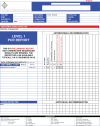Next-Generation Sequencing for Pathogen Identification in Infected Foot Ulcers
- PMID: 35097461
- PMCID: PMC8702686
- DOI: 10.1177/24730114211026933
Next-Generation Sequencing for Pathogen Identification in Infected Foot Ulcers
Abstract
Background: Accurate identification of primary pathogens in foot infections remains challenging due to the diverse microbiome. Conventional culture may show false-positive or false-negative growth, leading to ineffective postoperative antibiotic treatment. Next-generation sequencing (NGS) has been explored as an alternative to standard culture in orthopedic infections. NGS is highly sensitive and can detect an entire bacterial genome along with genes conferring antibiotic resistance in a given sample. We investigated the potential use of NGS for accurate identification and quantification of microbes in infected diabetic foot ulcer (DFU). We hypothesize that NGS will aid identification of dominant pathogen and provide a more complete profile of microorganisms in infected DFUs compared to the standard culture method.
Methods: Data were prospectively collected from 30 infected DFU patients who underwent operative treatment by a fellowship-trained orthopedic foot and ankle surgeon from October 2018 to September 2019. The average age of the patient was 60.4 years. Operative procedures performed were irrigation and debridement (12), toe or ray amputation (13), calcanectomies (4), and below-the-knee amputation (1). Infected bone specimens were obtained intraoperatively and processed for standard culture and NGS. Concordance between the standard culture and NGS was assessed.
Results: In 29 of 30 patients, pathogens were identified by both NGS and culture, with a concordance rate of 70%. In standard culture, Staphylococcus aureus (58.6%) was the most common pathogen, followed by coagulase-negative Staphylococcus (24.1%), Corynebacterium striatum (17.2%), and Enterococcus faecalis (17.2%). In NGS, Finegoldia magna (44.8%) was the most common microorganism followed by S. aureus (41.4%), and Anaerococcus vaginalis (24.1%). On average, NGS revealed 5.1 (range, 1-11) pathogens in a given sample, whereas culture revealed 2.6 (range, 1-6) pathogens.
Conclusion: NGS is an emerging molecular diagnostic method of microbial identification in orthopedic infection. It frequently provides different profiles of microorganisms along with antibiotic-resistant gene information compared to conventional culture in polymicrobial foot infection. Clinical use of NGS for management of foot and ankle infections warrants further investigation.
Level of evidence: Level II, diagnostic study.
Keywords: diabetic foot ulcer; foot infection; microbiological culture; next-generation sequencing.
© The Author(s) 2021.
Conflict of interest statement
Declaration of Conflicting Interests: The author(s) declared no potential conflicts of interest with respect to the research, authorship, and/or publication of this article. ICMJE forms for all authors are available online.
Figures

Similar articles
-
Comparative study of culture, next-generation sequencing, and immunoassay for identification of pathogen in diabetic foot ulcer.J Orthop Res. 2021 Dec;39(12):2638-2645. doi: 10.1002/jor.25001. Epub 2021 Feb 15. J Orthop Res. 2021. PMID: 33543785 Free PMC article.
-
Microbial Community Distribution and Core Microbiome in Successive Wound Grades of Individuals with Diabetic Foot Ulcers.Appl Environ Microbiol. 2020 Mar 2;86(6):e02608-19. doi: 10.1128/AEM.02608-19. Print 2020 Mar 2. Appl Environ Microbiol. 2020. PMID: 31924616 Free PMC article.
-
Diagnosis and treatment of diabetic foot infections.Plast Reconstr Surg. 2006 Jun;117(7 Suppl):212S-238S. doi: 10.1097/01.prs.0000222737.09322.77. Plast Reconstr Surg. 2006. PMID: 16799390
-
Metagenomics to Identify Pathogens in Diabetic Foot Ulcers and the Potential Impact for Clinical Care.Curr Diab Rep. 2021 Jun 21;21(8):26. doi: 10.1007/s11892-021-01391-7. Curr Diab Rep. 2021. PMID: 34152440 Review.
-
The dynamic wound microbiome.BMC Med. 2020 Nov 24;18(1):358. doi: 10.1186/s12916-020-01820-6. BMC Med. 2020. PMID: 33228639 Free PMC article. Review.
Cited by
-
Direct metagenomics investigation of non-surgical hard-to-heal wounds: a review.Ann Clin Microbiol Antimicrob. 2024 May 3;23(1):39. doi: 10.1186/s12941-024-00698-z. Ann Clin Microbiol Antimicrob. 2024. PMID: 38702796 Free PMC article. Review.
-
Comparing NGS-Based identification of bloodstream infections to traditional culture methods for enhanced ICU care: a comprehensive study.Front Cell Infect Microbiol. 2024 Sep 12;14:1454549. doi: 10.3389/fcimb.2024.1454549. eCollection 2024. Front Cell Infect Microbiol. 2024. PMID: 39328359 Free PMC article.
-
Next Generation Sequencing in orthopaedic infections - Where is the road headed?J Clin Orthop Trauma. 2024 Mar 26;51:102397. doi: 10.1016/j.jcot.2024.102397. eCollection 2024 Apr. J Clin Orthop Trauma. 2024. PMID: 38585384 Free PMC article.
-
Advancements in pathology: Digital transformation, precision medicine, and beyond.J Pathol Inform. 2024 Nov 19;16:100408. doi: 10.1016/j.jpi.2024.100408. eCollection 2025 Jan. J Pathol Inform. 2024. PMID: 40094037 Free PMC article. Review.
-
Metagenomic analysis demonstrates distinct changes in the gut microbiome of Kawasaki diseases children.Front Immunol. 2024 Jul 22;15:1416185. doi: 10.3389/fimmu.2024.1416185. eCollection 2024. Front Immunol. 2024. PMID: 39104524 Free PMC article.
References
-
- Armstrong DG, Boulton AJM, Bus SA. Diabetic foot ulcers and their recurrence. N Engl J Med. 2017;376(24):2367–75. - PubMed
-
- Gardner SE, Frantz RA, Troia C, et al. A tool to assess clinical signs and symptoms of localized infection in chronic wounds: development and reliability. Ostomy Wound Manage. 2001;47(1):40–47. - PubMed
LinkOut - more resources
Full Text Sources
Research Materials
